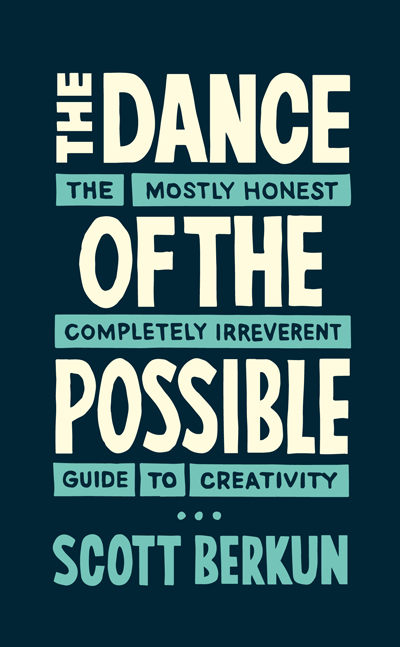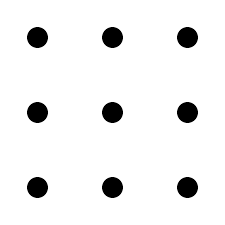Does “think outside the box” help? Popular creativity cliches explained
 While researching The Dance of the Possible: the mostly honest, completely irreverent, guide to creativity, I studied the history of some of the most misleading ideas that have been popularized about creativity. Similiar to the Myth of Epiphany and the other creative myths of innovation, these sayings are misleading despite their popularity.
While researching The Dance of the Possible: the mostly honest, completely irreverent, guide to creativity, I studied the history of some of the most misleading ideas that have been popularized about creativity. Similiar to the Myth of Epiphany and the other creative myths of innovation, these sayings are misleading despite their popularity.
You likely hear these terms often, but here is the background you need to use them to help you:
1. Where “Think outside the box” comes from: The implication of this popular phrase is that you should challenge assumptions and test constraints, but anyone who says this phrase is betraying their own advice. If they were helping to solve the problem at hand they’d offer a specific idea, or solution, that qualified as “out of the box” thinking, rather than simply saying the phrase and demanding that someone else do it. It’s like yelling at someone to “bake the cake” when you yourself don’t know how to bake a cake either.

The phrase comes from the 9-dot puzzle that was used in a research study conducted by J.P. Guilford in the 1970s (although the puzzle itself dates back to at least 1914). The trick to the puzzle is to ignore a common, but unstated, constraint that puzzles like this usually have. The implication is that we invent false constraints all the time: and this is the one nugget of usefulness in the whole puzzle story. Challenging constraints is one approach to problem-solving.
However it turns out that being told to think outside the box doesn’t actually help much. Recently different researchers replicated the Guilford study, but gave one group the advice to, more or less, ‘think outside the box’. The result? It didn’t significantly change the results. This shouldn’t be a surprise. Simply telling someone to do something hard doesn’t make it any easier. Our brains like to be efficient and assuming rules and constraints is what our brains are largely designed to do (some optical illusions demonstrate this well).
More broadly, logic puzzles like the 9-dot example rarely teach us much. They often depend on a single trick or hidden assumption, which is a poor representation of the skills of problem solving and idea generation required to develop ideas in the real world. It’s far more useful as a leader to demonstrate good thinking, or create a healthy environment where interesting ideas are explored, than simply to demand other people engage in something simply because you say a phrase or post a sign.
The best intent of the phrase “think outside of the box” is to reevaluate the constraints you are assuming to be true. If you can find a false constraint, something you are assuming is required but isn’t, it often leads to more and better ideas. In the 9 dot puzzle the false constraint is the box, but on a project a false constraint could be you’re assuming a deadline that isn’t true, or a requirement from a customer that can be shifted or redefined. Making a list of all the constraints you are assuming to be true, and vetting them often yields one or more that can be modified to allow for other ideas to be explored.
For fun, there are many creative solutions to the 9 dots puzzle.
2. The misnomer of Left brain / Right brain. Dan Pink unfortunately popularized this notion in his popular, but problematic, book A Whole New Mind – despite the left/right brain notion being mostly a misunderstanding of science. It is true that we do have two hemispheres in our brains, but the way they interact is complex and many areas on both sides contribute to what we describe as creativity.
The left/right brain concept goes back many years, but it was neuroscientist Michael S. Gazzaniga’s research in the 1960s that demonstrated how there are different functional centers in the brain. He performed tests where one part of the brain, in a patient with a head injury, clearly didn’t understand or know what the other part of the brain was doing. But the conclusion was not one of dominance – “you can’t be right brained any more than you can be right lunged or right kidneyed”.
People love easy, binary models for things and take pride in basing our primitive notions on the pretense of science. This is why people still say “he’s left brained” or “I’m a right brained person” despite how misguided those labels are. The Myers-Briggs test has similiar problems of being popular for how it satisfies our emotional needs to identify ourselves, more than anything to do with science or how personalities work.
Of course it is fair to label our personalities, as some people are more logical or free spirited than others, but it’s a mistake to confuse this with anything structural about how our brains work. As Jeffrey Anderson, a brain researcher, said: “It is certainly the case that some people have more methodical, logical cognitive styles, and others more uninhibited, spontaneous styles… this has nothing to do on any level with the different functions of the [brain’s] left and right hemisphere.”
3. Blue sky (constraint free) thinking. This phrase, most often used in product design and marketing, is a request to eliminate all constraints, and to work on a project free of any restrictions. The problem is that the benefits of working on a blue-sky project are often, but not always, more romance than reality. Constraints are very useful in finding new ideas. The request to ‘think blue sky’ can often lead people into the trap of ignoring seemingly smaller, or simpler ideas, that, if explored, could lead to the best solutions.
It can certainly be fun to think about solving bigger or more open problems. Imagining what you’d do with a 500% larger budget or an extra month of project schedule might yield an insight that transfers back to the actual constraints. But the desire to work ‘blue sky’ reflects a misunderstanding of how constraints often help, rather than hinder, the creative process.
A constraint, which can initially seem frustrating, is an important kind of information. It gives you something to start with, and work against in generating and testing ideas (and some research support this). For example, it’s much easier to write a poem that rhymes, than to write one in free verse. The structure of a rhyme provides information to work with and a structure, or shape, to try putting ideas into. Dr. Seuss famously wrote The Cat in The Hat based on a constraint from the publisher to use less than 250 different words.
There are many different kinds of constraints, and the way the constraint is defined can change how useful or not it is in solving a problem. Often it’s defining the problem thoughtfully, and working to examine and study the nuances of its constraints, that is where the real big insights are found. This is especially true when working on projects where you are designing something for other people.
Of course having too many constraints, or ones that conflict with each other, can render a problem unsolvable. Sometimes people are asked to do 1st rate work on a 3rd rate budget and it’d be unfair to tell them that if they were creative enough they could succeed.
If you want more honest advice on creative thinking, check out The Dance of the Possible: the mostly honest, completely irreverent, guide to creativity,
(Thanks to the folks on twitter who suggested some of the above).

I love the new bearded look!
Oh, sorry, yes, love your writing, as always, and i agree with it all, and well put. The only thing i thought about was whether the statements were something that was being done, something wanted, or something offered, as the context of these changes how i feel about them. For example, most expressions of thinking outside the box, as you point out, is a cry for better problem solving but still within certain constraints, but when i offer that as a consultant it is more or less only about challenging those constraints. I guess the usage of the terms change their meaning quite a lot.
Aaaargh, more stuff i have to think about today … Thanks, Scott. :)
P.S. love the beard
> “something that was being done, something wanted, or something offered,”
This is a good clarifying question. Part of my point is the phrase is often used as something wanted – it’s a request: “I want YOU to think outside the box”. It’s far more productive to show what you want, or, as you suggest, actually challenge a specific constraint (e.g. “lets assume for now the budget is unlimited”).
Its surprising how creative we are when we are kids but the more time we spend in schools and start living on constraints, we limit ourselves and kill our creativity.
Very useful advice
The concept “Think outside the box” is reminded quite more on design. It wants to remind the designer is continuous innovation. This article brings a different opinion about this concept, so we should look it at many side.
Very well explained. Keep it up!
wow… so thoughtful there.
awesome post Scott
Misleading and useless just as you put it. The truth is, when one is told to think outside the box, they ignore the little things inside the box. We then start sophisticating stuff. Yet the answer in most cases is inside the so called box.
What about “think like a kid”?
Just thinking like a kid :)
thanks
It is true that we do have two hemispheres in our brains, but the way they interact is complex and many areas on both sides contribute to what we describe as creativity.
Yes it does help !
Its astonishing how imaginative we are the point at which we are kids yet the additional time we spend in schools and begin living on limitations, we confine ourselves and kill our inattentiveness.
wow… so thoughtful there. This article brings a different opinion about this concept, so we should look it at many side. Keep it up.
Thanks, Scott. Mainly I like this point “blue sky thinking”. Just wonderful thought. It will really help.
I love Whole New Mind Book by Daniel Pink. It is eye opening. Really interesting read. Left brain / Right brain theory is fascinating!
There were major problems with Whole New Mind, especially regarding his sloppy use of science. I detailed some of them in my review of the book.
Thank you for providing this valuable information. BTW, I like the ‘blue sky thinking’ point.